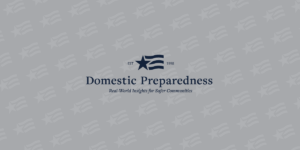

Public Health Emergency Resilience: The Next Challenging Step
Bruce Clements
February 23, 2011
The four keys to maintaining and improving the nation’s public health and emergency preparedness, according to HSPD-21 and other policy directives, are improved capabilities in bio-surveillance, countermeasures distribution, mass-casualty care, and community resilience. Considerable progress has been made in upgrading the first three of those essential “components” – but the term “resilience” is still not very well understood, neither by national decision-makers nor by the American people at large.

The Missing Leg of a Well Balanced Facility Security Platform
Joseph W. Trindal
February 23, 2011
The protection of high-value sites is one of the principal tasks spelled out in federal, state, local, and private-sector resilience policies and programs – most of which focus primarily on risk assessments, advance planning, and the implementation of effective security measures. A “fourth leg” – functional security testing – is needed, though, to balance and buttress the other three legs that have to date been receiving the bulk of attention, and most of the fiscal resources as well.

USCG’s Small-Vessel Security Strategy Ready for Launch
Corey Ranslem
February 23, 2011
It might look like a yacht and might even maneuver like a yacht. But it could be, instead, a cleverly disguised missile launcher, in yacht’s clothing, entering New York Harbor or coming up the Potomac to strike a new blow for Islamic fundamentalism and against the wicked American imperialists. Here is a quick preview of how U.S. decision-makers are hoping to deal with this immensely violent new threat “From the Sea.”

Private Sector Language: Resilience & the Supply Chain Element
Dennis R. Schrader
February 16, 2011
Bureaucratic Abstractions vs. Private-Sector Certitudes – that is one of the more difficult problems, it says here, behind at least some of the “communications difficulties” between public and private-sector resilience professionals. Merging the two vocabularies would be a common-sense way to remove some current obstacles to achievement of the same goal.

The Three Ts of Terrorism – Finding the Facts in the News
Jordan Nelms
February 16, 2011
The Target hit, the Tactics used, and the Technology involved – all provide a wealth of information
that can be used by everyday citizens to find out the “real facts” behind a terrorist incident and/or
other mass-casualty event. Also not to be ignored is the telling clue, noticed only by Sherlock Holmes,
about the dog that did not bark.

Pre-Exposure Anthrax Vaccination: A Horse & Cart Situation
Thomas K. Zink
February 9, 2011
On one side of the scale is “probably less than one gram of anthrax.” On the other side are an estimated six million doses of vaccine thrown away each year – as well as, quite possibly, the deaths of hundreds of thousands of innocent people. It says here that the cost/benefit ratio is very much on the side of the terrorists.

Air National Guard Resumes Life-Saving CCATT Mission
Ellen Krenke
February 9, 2011
Despite facing some of the most deadly combat environments in the nation’s history, the d”saved
rate” of forward-deployed U.S. military units on the frequently shifting battleground in Pakistan and
Afghanistan is also at a record high – thanks in large part to the medics/corpsmen, doctors, nurses, and
CCATT-enriched aerovac units also serving on the front lines.

Disaster Resilience: An Emergency Manager’s Perspective
Kay C. Goss
February 9, 2011
Like the forward pass in football, “Resilience” was once a vague notion, theoretical concept, and interesting afterthought. In the past several years, though, it has become both the firm foundation for and operational imperative of a truly comprehensive preparedness plan. Here are some relevant comments from one of the nation’s most knowledgeable experts on the subject.

PTSD: Its Causes, Effects, and Possible Strategies
Joseph Cahill
February 2, 2011
It is now well documented that members of the nation’s armed forces who have been in combat later suffer from an extremely harmful aftereffect known as Post-Traumatic Stress Disorder, or PTSD. Many first responders face the same type of traumatic situations and display many of the same symptoms. What can/should be done about it? Your answers will help; please take the survey!

Storm Warnings: Communications and Utility Resilience
Omar Alkhalaf
February 2, 2011
After-action reports are valuable both in establishing precisely what went wrong, and why –
particularly if used to ensure that the same mistakes are not made a second time. They are even more
valuable, though, if used by other political jurisdictions as lessons learned to upgrade their own
preparations and advance-planning policies and procedures.

